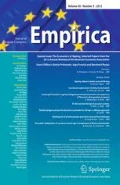Abstract
Both the Mexican crisis of 1994–95 and the Asian financial crisis of 1997–98 have been preceded by large current account deficits run by the affected economies. External deficits are often assumed to play an important role in the propagation of financial crises in emerging markets. Policymakers are faced with a new challenge: that of resisting or accepting the large current account deficits that may result from heavy private capital inflows. This paper aims at providing some guidance:
First, the Lawson Doctrine – according to which current account deficits that result from a shift in private-sector behaviour should not be a public policy concern – has been discredited by recent currency crises in Latin America and Asia. Second, define the size of current account deficits that should be sustainable in the long run. Third, the intertemporal approach to the current account does not provide a reliable benchmark to define when deficits become ‘excessive’. Fourth, large external deficits should be resisted if unsustainable currency appreciation, excessive risk-taking in the banking system and a sharp private spending boom are seen to coincide.
Similar content being viewed by others
References
Agosin, M.R. (1994) ‘Saving and Investment in Latin America', UNCTAD Discussion Papers, No. 90.
Andersen, P.S. and White, R.W. (1996) ‘The Macroeconomic Effects of Financial Sector Reforms: An Overview of Industrial Countries', mimeo, Basle: Bank for International Settlements.
Artus, P. (1996) ‘Le financement de la croissance par endettement extérieur', Document de travail No. 1996–05/T, Paris: Caisse des dépôts et consignations.
Blundell-Wignall, A. and Browne, F. (1991) ‘Macroeconomic Consequences of Financial Liberalisation: A Summary Report', ESD Working Paper No. 98, Paris: Organisation for Economic Co-operation and Development.
Borensztein, E., De Gregorio, J. and Lee, J-W. (1995) ‘How Does Foreign Direct Investment Affect Economic Growth?', NBER Working Paper No. 5057, Cambridge, MA: National Bureau of Economic Research.
Calvo, G. (1987) ‘On the Costs of Temporary Policy', Journal of Development Economics 27, 147–69.
Calvo, G. Leiderman, L. and Reinhart, C. (1996) ‘Inflows of Capital to Developing Countries in the 1990s', Journal of Economic Perspectives 10.2, 123–40.
Caprio, Jr., G. and Klingebeil, D. (1996) ‘Bank Insolvency: Bad Luck, Bad Policy, or Bad Banking?', Washington, DC: The World Bank.
Corden, W.M. (1977) Inflation, Exchange Rates and the International System. Oxford: Oxford University Press.
Corden, W.M. (1994) Economic Policy, Exchange Rates and the International System. Oxford: Clarendon Press.
Edwards, S. (1995) ‘Why are Saving Rates So Different Across Countries?: An International Comparative Analysis', NBER Working Paper No. 5097, Cambridge, MA: National Bureau of Economic Research.
Edwards, S., Steiner, R. and Losada, F. (1996) ‘Capital Inflows, the Real Exchange Rate and the Mexican Crisis of 1994', in H. Sautter and R. Schinke (eds.), Stabilization and Reform in Latin America: Where Do We Stand?, Frankfurt, Vervuert.
Frankel, J. and Rose, A.K. (1996) ‘Currency Crashes in Emerging Markets: Empirical Indicators', NBER Working Paper No. 5437. Cambridge, MA: National Bureau of Economic Research.
Fry, M. (1996) ‘How Foreign Direct Investment in Pacific Asia Improves the Current Account', Journal of Asian Economics 7(3), 459–486.
Gavin, M. and Hausmann, R. (1996) ‘The Roots of Banking Crises: The Macroeconomic Context', Working Paper Series 318, Washington, DC: Inter-American Development Bank.
Glick, R. and Rogoff, K. (1995) ‘Global versus Country-Specific Productivity Shocks and the Current Account', Journal of Monetary Economics, May.
Halpern, L. and Wyplosz, C. (1996) ‘Equilibrium Exchange Rates in Transition Economies', IMF Working Paper 96/125 (November).
Harberger, A. (1985) ‘Lessons for Debtor-Country Managers and Policymakers', In G.W. Smith and J.T. Cuddington (eds.), International Debt and the Developing Countries, Washington, DC: The World Bank, pp. 236–257.
Hausmann, R. and Reisen, H. (eds.) (1996), Securing Stability and Growth in Latin America: Policy Issues and Prospects for Shock-Prone Economies, Paris: Organisation for Economic Co-operation and Development.
Heller, H.R. and Khan, M.S. (1978) ‘The Demand for International Reserves Under Fixed and Floating Exchange Rates', IMF Staff Papers 25.4, 623–649.
Heymann, D. (1994) ‘En la interpretacion de la cuenta corriente', Economia Mexicana 3.1.
Kaminsky, G. and Reinhart, C.M. (1996) ‘The Twin Crises: The Causes of Banking and Balance-of-Payments Problems', Working Paper No. 17, University of Maryland at College Park: Center for International Economics.
Larraín, G. (1996) ‘Productividad del gasto publico y tipo de cambio real', In: F. Morande (ed.), Estudios empiricos de tipo de cambio real in Chile, Santiago de Chile: CEP/ILADES Georgetown University.
MacKellar, L. and H. Reisen (1998) ‘A Simulation Model of Global Pension Fund Investment', OECD Development Centre Technical Paper No. 136.
McKinnon, R. and Pill, H. (1995) ‘Credible Liberalizations and International Capital Flows', mimeo, Stanford University.
Milesi-Ferretti, G.M. and Razin, A. (1996) ‘Sustainability of Persistent Current Account Deficits', NBER Working Paper No. 5467. Cambridge, MA: National Bureau of Economic Research.
Obstfeld, M. and Rogoff, K. (1994) ‘The Intertemporal Approach to the Current Account', NBER Working Paper No. 4893. Cambridge, MA: National Bureau of Economic Research.
Razin, A. (1995) ‘The Dynamic-Optimizing Approach to Current Account', in P. Kenen (ed.), Understanding Interdependence: The Macroeconomics of the Open Economy, Princeton University Press, Princeton, N.J.
Reisen, H. (1993) ‘Integation with Disinflation: Which Way?', in R. O'Brien (ed.), Finance and the International Economy: 7, The Amex Bank Review Prize Essays, Oxford: Oxford University Press, pp. 128–145.
Reisen, H. (1996) ‘Managing Volatile Capital Inflows: The Experience of the 1990s', Asian Development Review 14.1, 72–96.
Reisen, H. (1998) ‘Net Capital Inflows: How Much to Accept, How Much to Resist?', in R. Glick (ed.), Managing Capital Flows and Exchange Rates: Perspectives from the Pacific Basin, Cambridge University Press, New York.
Sachs, J. and Warner, A. (1995) ‘Economic Reform and the Process of Global Integration', Brookings Papers on Economic Activity 1, 1–118.
Summers, L. (1988) ‘Tax Policy and International Competitiveness', in J.A. Frenkel (ed.), International Aspects of Fiscal Policies, University of Chicago Press, Chicago.
Author information
Authors and Affiliations
Rights and permissions
About this article
Cite this article
Reisen, H. Sustainable and Excessive Current Account Deficits. Empirica 25, 111–131 (1998). https://doi.org/10.1023/A:1006850620095
Issue Date:
DOI: https://doi.org/10.1023/A:1006850620095




